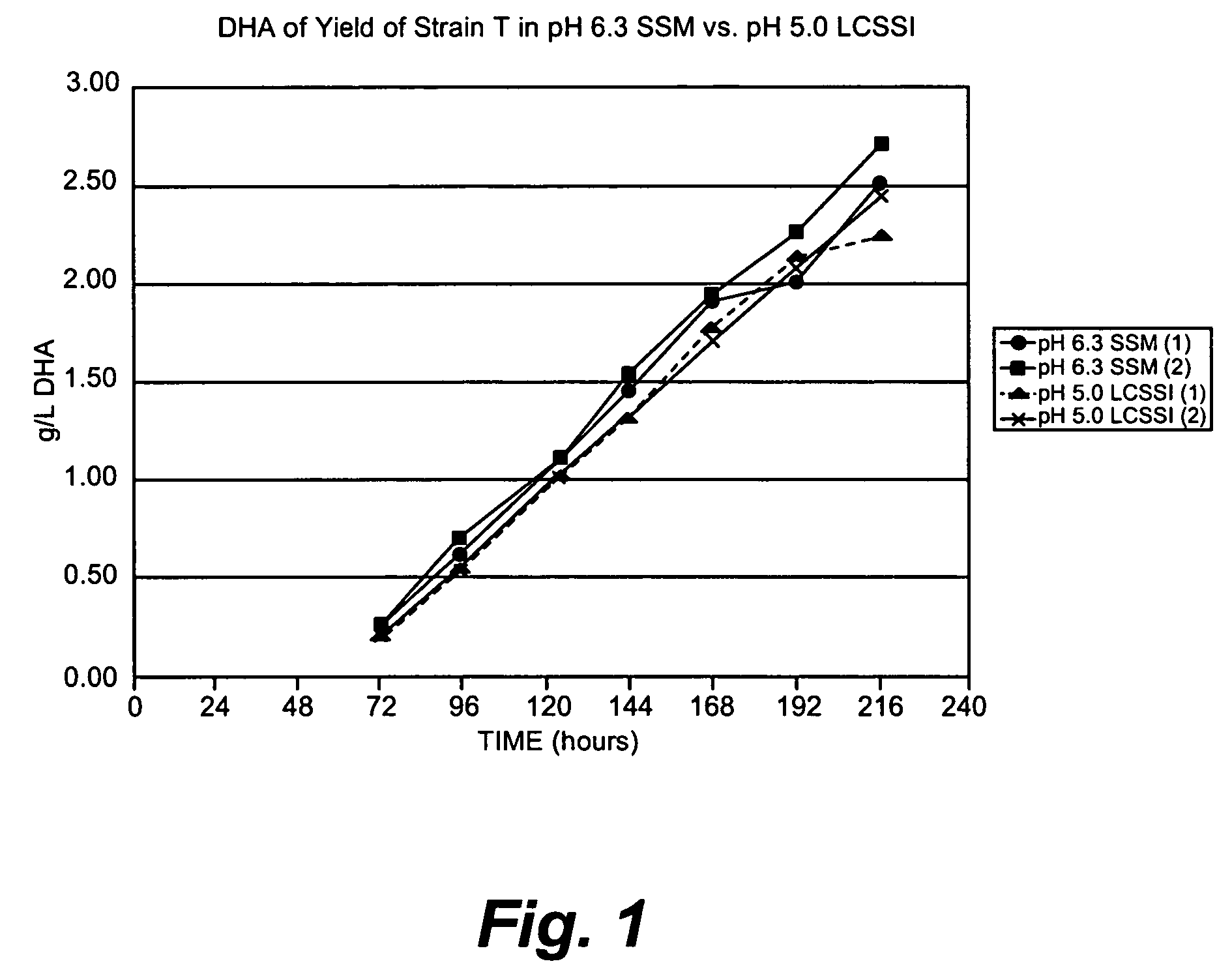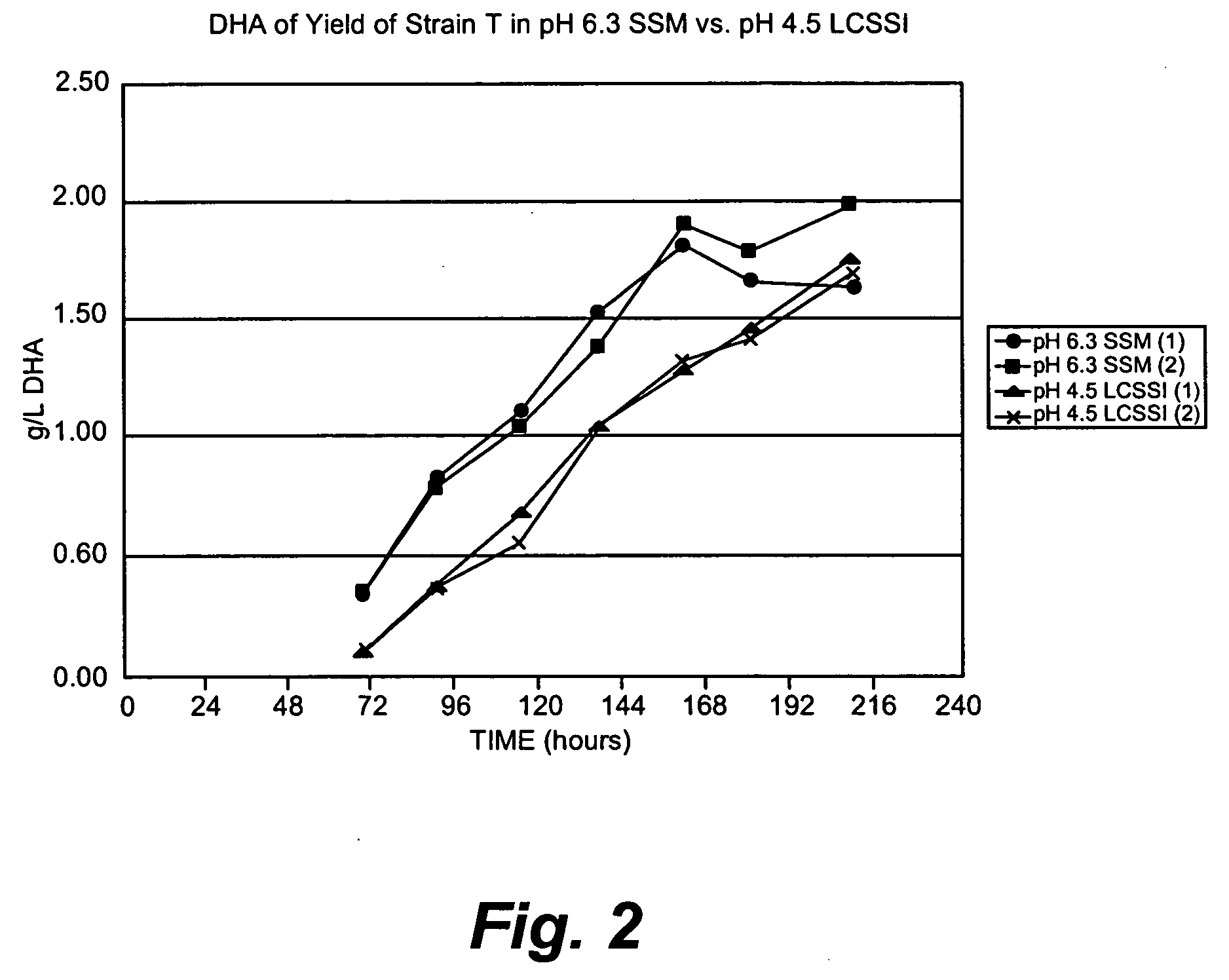Production of high levels of DHA in microalgae using modified amounts of chloride and potassium
a technology of chloride and potassium, which is applied in the field of production of high unsaturated fatty acids by marine microorganisms, can solve the problems of further decrease in the dha yield of culture, and achieve the effect of reducing sodium chloride levels
- Summary
- Abstract
- Description
- Claims
- Application Information
AI Technical Summary
Benefits of technology
Problems solved by technology
Method used
Image
Examples
example 1
[0041] This Example describes the preparation of Standard Screening Medium (SSM) with 4.5 g / l NaCl. To prepare the media, the first step includes adding the following compounds to distilled water to 90% of final desired volume as shown in Table 1. All compounds are available from Sigma Aldrich, St. Louis, Mo.
TABLE 1Amounts and Final Concentrations of media before autoclavingAmountAmountAmountFinalchloride ionpotassium ionsodium ionCompoundConcentrationadded (g / l)added (g / l)added (g / l)CaCl2—2H2O10.3g / l0.09MgSO4—7H2O1.25g / lNaCl4.5g / l31.5MES10.7g / lMSG1.5g / lTastone 1540.5g / lKH2PO40.014g / l.004KCl0.14g / l0.0670.073CuSO4—5H2O0.15 × 10−3g / lCoCl2—6H2O0.3 × 10−3g / lnegligibleH3BO310 × 10−3g / lMnCl2—4H2O4.5 × 10−3g / lnegligibleZnSO4—7H2O0.3 × 10−3g / lNaOH (to adjust pH to 6.3)1.16g / l0.67FeCl226 × 10−3g / mlnegligibleThiamine31 × 10−3g / lglucose450g / ltotal of each ion3.160.082.17
1Calcium chloride dihydrate is 244 g / mol with 28.7% chloride.
2stock solution autoclaved separately and added in a sterile ...
example 2
[0043] This Example describes the preparation of 1000 ppm chloride ion Screening Medium (SSM) with 1.41 g / l NaCl (that together with calcium chloride and potassium chloride results in approximately 1000 ppm, 1 g / l chloride ion). To prepare the media, the first step includes adding the following compounds to deionized distilled water to 90% of final desired volume as shown in Table 2. All compounds are available from Sigma Aldrich, St. Louis, Mo.
TABLE 2Amounts and Final Concentrations of media before autoclavingAmountAmountAmountchloride ionpotassium ionsodium ionCompoundFinal Concentrationadded (g / l)added (g / l)added (g / l)CaCl2—2H2O0.3g / l0.09MgSO4—7H2O1.25g / lNaCl1.41g / l0.850.47MES10.7g / lMSG1.5g / lTastone 1540.5g / lKH2PO40.014g / l0.004KCl0.14g / l0.0670.073CuSO4—5H2O0.15 × 10−3g / lCoCl2—6H2O0.3 × 10−3g / lnegligibleH3BO310 × 10−3g / lMnCl2—4H2O4.5 × 10−3g / lnegligibleZnSO4—7H2O0.3 × 10−3g / lNaOH (to adjust1.6g / l0.67pH to 6.3)FeCl216 × 10−3g / lnegligibleThiamine21 × 10−3g / lBiotin22 × 10−6g / lgluco...
example 3
[0045] This Example describes the preparation of 300 ppm chloride ion Screening Medium (SSM) with 0.211 g / l NaCl (that together with calcium chloride and potassium chloride results in 0.3 g / l chloride ion). To prepare the media, the first step includes adding the following compounds to deionized distilled water to 90% of final desired volume as shown in Table 3. All compounds are available from Sigma Aldrich, St. Louis, Mo.
TABLE 3Amounts and Final Concentrations of media before autoclavingAmountAmountAmountFinalchloride ionpotassium ionsodium ionCompoundConcentrationadded (g / l)added (g / l)added (g / l)CaCl2—2H2O0.3g / l0.09MgSO4—7H2O1.25g / lNaCl0.211g / l0.130.07MES10.7g / lMSG1.5g / lTastone 1540.5g / lKH2PO40.014g / l0.004KCl0.14g / l0.0670.073CuSO4—5H2O0.15 × 10−3g / lCoCl2—6H2O0.3 × 10−3g / lnegligibleH3BO310 × 10−3g / lMnCl2—4H2O4.5 × 10−3g / lnegligibleZnSO4—7H2O0.3 × 10−3g / lNaOH (to adjust pH1.16g / l0.67to 6.3)FeCl216 × 10−3g / lnegligibleThiamine21 × 10−3g / lBiotin22 × 10−6g / lglucose350g / ltotal of each...
PUM
| Property | Measurement | Unit |
|---|---|---|
| concentration | aaaaa | aaaaa |
| concentration | aaaaa | aaaaa |
| concentration | aaaaa | aaaaa |
Abstract
Description
Claims
Application Information
 Login to View More
Login to View More - R&D
- Intellectual Property
- Life Sciences
- Materials
- Tech Scout
- Unparalleled Data Quality
- Higher Quality Content
- 60% Fewer Hallucinations
Browse by: Latest US Patents, China's latest patents, Technical Efficacy Thesaurus, Application Domain, Technology Topic, Popular Technical Reports.
© 2025 PatSnap. All rights reserved.Legal|Privacy policy|Modern Slavery Act Transparency Statement|Sitemap|About US| Contact US: help@patsnap.com


